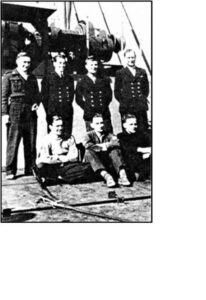| Lieutenant Kenneth Robert Hudspeth, RANVR was one of manyRoyal Australian Naval personnel whose service in Royal Navy units during the darkest days ofWorld War 2 has gone largely unnoticed in Australia. This story of the self-reliant and courageous LEUT Hudspeth who completed several hazardous missions in the then SECRET, X-Craft (midget submarine) earned him the Distinguished Service Cross and two Bars. |
| Thanks to a research query about Hudspeth received by the Society, the story of his remarkable war service can be told. This story was researched and compiled byDennis J. Weatherall JP TM AFAITT(L) LSM an active volunteer of the Society. Dennis is aqualified Australian Military Historian and accredited Member of the International Guild ofBattlefield Guides. |
| EarlyLife |
| Kenneth Hudspeth was born in Echuca, Victoria on the Murray Riveron 31 March 1918. His Father Robert was born in 1891 in Carlton, and mother Ada (nee Sim)in 1894 in Box Hill, Victoria. There were two other brothers born into the Hudspethfamily, Bruce in 1919 and Donald 1921 in Hobart, Tasmania. |
| Robert Senior started work at 14 years of age and studied at nightschool to become a teacher. He went on to become the first Principal of Hobart Technical Collegehaving established the school, recruited and trained staff in the specific trades required. |
| Kenneth Robert Hudspeth, was encouraged by his father to be aware of the bushland, and became a keen bushwalker in Tasmania’s south-west region. He was also interested in all water activities and subsequently became a Sea Scout and crewed local cruising yachts.With such involvement, Kenneth never lost his deep interest in maritime matters. |
| On finishing school Kenneth, following in his father’s footstepsbecame a trainee in the Tasmanian Education Department and was assigned to Hythe areaschool in the suburb of Southport following training. |
| EarlyCareer |
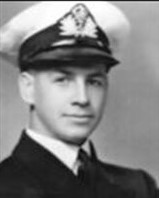 Hudspeth – 1940 Following the outbreak of WWII, Kenneth offeredhis service to the Navy and was selected as a Sub Lieutenant RANVR.His first posting being to HMAS Cerberus for induction followed by HMAS Rushcutter to undertake Anti-Submarine warfaretraining in the newly established school commanded by CMDR Harvey Newcomb RN. |
| During the Battle of the Atlantic up to 20 percent ofall A/S Officers were Australian RANR/RANVR serving in the Royal Navy (RN). |
| Hudspeth departed for the UK in the “ImperialStar” in January. Postings then followed in quick succession and included; HMS Ferret and HMS Clarkia. After gaining his BridgeWatchkeeping Certificate and serving 15 months on North Atlantic convoy escort duties in 1941& 1942, he volunteered for submarines and was posted to HMS Dolphin, HMS Cyclops(Submarine Depot Ship) and from October 1942 to August 1944, HMS Varbel I and II. |
| He was promoted LEUT RANVR on 15th January 1943 and assignedfor commanding officer duties in Midget Submarine “X-Craft”. His first command was X-Craft X10. |
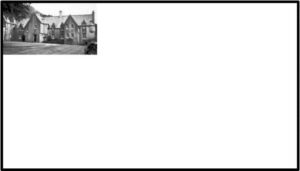
requisitioned by the Admiralty early in the war
and became HQ for the 12thSubmarine Flotilla,
located at the head of Loch StrivenScotland.
“Bute’s War”, locations of HMSVarbel I and II
| HazardousService |
| The Admiralty had requested volunteers for special and hazardous service, stating they must be below 24 years of age on selection, unmarried, be good swimmers and of strong and enduring physique”. After volunteering and selection interview at HMS Dolphin Hudspeth was accepted without an explanation of what ‘hazardous service’ was. He wassubsequently posted to HMS Cyclops then HMS Varbel where he commenced training (and was toldwhat hazardous service he’d just volunteered for). Training commenced immediately in thenew midget submarines known as X-Craft. |
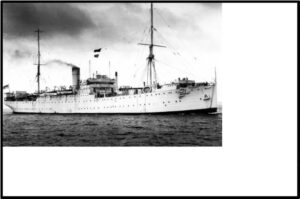
HMS Cyclops (F31) depot ship forthe 7thSubmarine Flotilla home based atRothesay 1940-1946. Originally the passenger liner “Indrabarah”
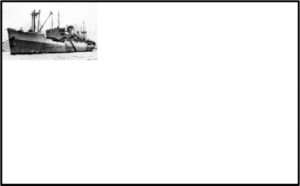
Co. in Greenock, Scotland for the Scottish “ClanLine”, it was to be launched as “Clan Campbell” but the Admiralty requisitioned her on the day she was launched – 27th October 1942
| Operation Source was a Top Secret Operation to neutralise threeGerman Capital ships, SMS Tirpitz, Scharnhorst and Lutzow. Hudspeth was one of six midgetsubmarine CO’s detailed to attack these vessels. His target was the battleship SMS Scharnhorst,later downgraded by the RN to a Battlecruiser due to carrying only 11 inch main guns. Allwere at anchor in the Kaa Fjord. |
| X5 was the Mission commander commanded by Commander LEUT“Henty” Henty-Creer RN who was Australian born. X6 was commended by LEUT Donald Cameron RNR and X7 commanded by LEUT Godfrey Place RNR. These three X-Craft weredetailed to attack the SMS Tirpitz. X5 was lost with all hands either during the attack or withdrawal(there is no definitive record), although the Admiralty refuses to dive on the wreck (locatedin 1974) to check if, in fact, they had deployed their two tons of explosives and were actuallysunk on their escape from completing their attack on Tirpitz. Both X6 and X7 succeeded indamaging their target, although both X-Craft were forced to the surface within the anti submarine netaround the Tirpitz. Both were craft were scuttled. Two X7 crew members never escaped theircraft. The six surviving crew members were taken as prisoners of war (POW’s). Both CO’sCameron and Place were awarded the Victoria Cross. |
| On the 18th September 1943, X8 commanded by LEUT J Smart RNVRwas en-route to attack the SMS Lutzow (Pocket Battleship). It was under tow by its mothersubmarine, HMS Sea Nymph when the tow line parted. It was found the next day. As LEUTSmart had been forced to jettison both saddle charges during the passage X8s participation in the mission was cancelled. Unfortunately, X8 was scuttled on the 18th September and the crewreturned to the “mother” submarine for passage home. |
| X9 commanded by SBLT E.V. Kearon RNVR and X10 weredesignated to attack SMS Scharnhorst on the 16th September 1943. Unfortunately, X9 under towfrom HM Submarine Syrtis had dived and failed to surface on the same day. It was found thetowing hawser had also parted. All four of its crew were lost. |
| X10’s target was the SMS Scharnhorst, believedat the time of departure from home base to be at anchor astern ofthe SMS Tirpitz in the Kaa Fjord. Unknown to X10 as at 1300, 12 September when she left base under the tow of HM Submarine Sceptre, theScharnhorst had slipped her moorings on the morning of 22September and headed to Alten Fjord to undertake Gunnery practice.Subsequently, Scharnhorst received a signal from Tirpitz advising she’d been under attack and had been torpedoed. As a consequence, Scharnhorst didnot return to her berth in the Kaa Fjord. This situation unknown toLEUT Hudspeth became important post mission.
|
| After slipping her tow from HM Submarine Sceptre at 2000 on 20September, X10 dived to test her trim. All was satisfactory, so course was set for the allocated targetSMS Scharnhorst. Given known technical reliability issues with the X-Craft it is not surprisingthat Hudspeth was beset with multiple mechanical break downs. First the periscope motor startedto smell pungent when raised and lowered, then the motor burnt out and the craft filled withfumes. Next the Gyro compass failed as did the magnetic compass light, finally the boat started to leak above the switchboard and all fuses blew. Every crew member, regardless of trade,was put to work in anendeavour to rectify the defects and hopefully resume X10 its mission.At 0215, X10 bottomed out at 195 feet just 4 miles from Kaa Fjord and where it was presumed SMS Scharnhorst was at anchor. Finally, one of the two side saddles (explosives) flooded. Itseemed little else could go wrong? |
| LEUT Hudspeth asked his crew if they wanted to proceed to theirtarget in the condition they now found themselves in. All responded yes. After serious considerationas their CO and having heard multiple explosions at 0815 from the other attacking X-Craft, heweighed carefully if he should continue and if forced to the surface, the consequences of losingboth his craft and crew.
He also considered the impact on other craft successfully attackingtheir targets. X10 stayed bottomed all day then at 1800 Hudspeth called off the mission andlimped back down the Fjord to the rendezvous for return to Loch Striven, Scotland. |
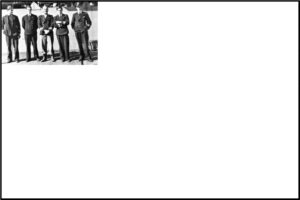
Henty-Creer RNVR. Left to right; LEUT T Martin RN X9, LEUT Kenneth Hudspeth RANVR X10,
LEUT Basil McFarlane RAN X8, LEUT Godfrey Place RNR X7 and LEUT Donald Cameron RNR X6.
| LEUT Hudspeth was awarded a DSC (Distinguished Service Cross) on11 January 1944. His citation read: “For outstanding courage whilst in command of HMSubmarine X10 during Operation Source in September 1943. This submarine penetrated AltenFjord on 22 September in enemy waters throughout 22 September while he and his crew worked in trying conditions to make good the vessel’s defects. The attempt was in vain and LEUTHudspeth had to come to the correct though bitter decision to withdraw, when so near his goal.The successful doublesage of the approaches to Alten Fjord required determination and skill of a high order. The application and endurance shown in the attempt to remedy defects deserve credit. The information this Officer was able to bring back was of great value”.
|
| Operation Postage Able: 17 to 21 January 1944 |
| As the planning went ahead for the invasion of Europe, scheduled for thesummer of 1944, it was realised that the Admiralty had no close inshore charts of the French coastline. Therefore, towards the end of 1943 (December) a group of specialised servicemenarrived at the X-Craft Scottish base to check out if it was possible to use these craft to gainthe information required for the upgrade of what would become the “invasion charts”. Thename of the group was Combined Operations Pilotage Parties (COPP) their role was to gain allpossible information on the shore line both above and below the expected tide levels. TheNormandy coast was their target shoreline. COPP was a mixture of Naval and Army personnel,the latter being trained commando swimmers. It was Navy’s job to take these commandos,land them unseen to reconnoitre ashore before returning to their X-Craft for passage home. |
| Two X-Craft (X20 and X23) were shipped by rail from Loch Striven(Scotland) to Portsmouth (south coast) for the operation. The original crew from X10 that was scuttled on its return from the aborted SMS Scharnhorst raid (Sep 43) were reassigned to X20 wherethey practised passage in the shallow waters of the Solent. |
| Due to last minute “second thoughts”by senior officers, the first planned COPP mission was carried out by small surface craft. Theplanners were concernedabout the possible discovery by the enemy of an X-Craft operation closeinshore. |
| LEUT Hudspeth was awarded a bar to his DSC on 4 April 1944 for hismissions in landing COPP personnel on enemy held coasts, his citation reads; “For outstanding courage and devotion to duty whilst commanding HM Submarine X20 in hazardous operations. He showed great coolness, grasp and ability in manoeuvring his X-Craft submerged in shallow water close under enemy defences during the first attempt at putting CombinedOperations Pilotage Parties on beach reconnaissance on a heavily guarded position of an enemy coast, in unknown and unpleasant conditions during the period 17 to 21 January 1944”. |
| Following the successful charting of the Normandy coast X20 and X23were retained for the subsequent operation, Operation Gambit. LEUT Hudspeth continued incommand of X20 whilst LEUT George Honour RNVR was CO of X23. For this operation thethe crew of each was to be five men. Originally designed for a crew of three, each carrieddivers and one other. Conditions were cramped! |
| This operation was part of the overall D-Day Naval Operation known as“Operation Neptune”. Basically both craft had to approach the British / Canadian allocatedsector beaches and position themselves at the outer markers of Sword (X23) and Juno (X20). Theirrole was to sit it out until the allocated time and date of the invasion, then surface and act asnavigation beacons for landing force craft heading to the two beaches. |
| With D-Day set for Monday 5 June 1944, both X-Craft left their berthsat Fort Blockhouse and set course to exit the east gate on the Portsmouth Boom Defence.Operation “Gambit” had commenced. It was Friday 2 June at 2130 hours. The X-Craft wereunder tow by two trawlers the Darthem (X20) and the Sapper (X23), they broke their tow the next day and headed for what are now known as Sword and Juno invasion beaches. They positionedthemselves (submerged) on the 4 June to be the leads for the biggest invasion force the world had ever seen. |
| The X-Craft needed to ventilate every five hours to draw in fresh air.They also had to confirm their allocated station by periscope sightings each evening. At 2200daily they tuned into the BBC news broadcast for any coded message that would confirm the landings would commence the following morning. During one such broadcast, the code wastransmitted that the invasion landings would be delayed due to weather (at the UK end) for a day.As their supplies were limited, especially oxygen backup (in bottles) this message caused someconcern onboard X20. Their mission on D-Day was to illuminate mast head beacons (tosea) from the deck and periscope to give the landing armada a tested navigation course to theirlanding beaches of Sword and Juno. |
| The allocation of operation names is of interest. In this case theAdmiralty had chosen Gambit which, as in Chess, a piece is risked so as to gain advantage later! Nowords were ever so true for X20 and X23. |
| For this mission not only did they carry extra crew but enoughequipment to open a deep sea fishermen’s store! Before departure Portsmouth they stowed onboard thefollowing kit: |
| Two coastal quick release anchors,
Three flashing lamps with batteries, Several taut-string measuring reels, Two small portable radar beacons, One 18 foot sounding pole with two telescopic masts of similar length and Twelve extra bottles of oxygen in addition to the X-Crafts normal fixed supply. |
| The crew were given fake identification papers and told if the mission was aborted they were to swim ashore make contact with the local resistance who would help them return to England. That is of course, if they weren’t drowned or shot by German sentries.If they survived and escaped, they still had to find the local resistance which was easier saidthan done. Essentially, they were on their own if the mission was aborted. |
| X20 positioned herself off Juno Beach less than a mile and a half fromthe coast on Sunday 4 June 1944. When the coded message was received it simply read“trouble in Scarborough” so X20 manoeuvred into deeper water to wait until Tuesday 6 June, thenew D-Day. At 0502 the periscope was raised along with the telescopic mast, lights affixed(looking seaward) the radio beacons and echo sounders activated……the final phase of the invasionof Europe was about to commence! |
| X20 had completed her mission successfully so had X23, so thecrew hunkered down had breakfast and waited until it was time to get themselves off the beach and rendezvous with their two craft for a well-deserved return to Portsmouth. |
| For this operation, LEUT Hudspeth was awarded a second bar to his DSCon 28 Nov 1944. The citation read: “For gallantry, skill, determination and undaunteddevotion to duty whilst commanding HM Submarine X20 during Operation Gambit, the Combined Operations Pilotage Parties beach reconnaissance of the French coast prior to OperationNeptune and the landing of Allied Forces on the coast of Normandy”. |
| After D-Day LEUT Hudspeth was posted back to HMS Varbel (12thSubmarine Flotilla – Midget X-Craft) and was involved in training new crew, he also wrote a manual on X-Craft operations, something he was well suited for having been a teacher prior to his war service. |
| On the 23 September 1944LEUT Hudspeth was posted toHMS Orwell G98) an Oscar Class destroyerand back to his old trade as an Anti-Submarine Officer. The Orwell had beenlaunched on 2 April 1942, commissioned 17 October 1942 and assigned immediately to North Atlantic and RussianConvoy duties. LEUT Hudspethserved under LCDR John Randall Gower,CO from 5 July 44 through to 16October 1945. |
| During Hudspeth’s time onboard most sailings were on the Russianrun north until returning to Scapa Flowat the endof April 1945 Orwell rejoined the Home Fleet and assumed duties asrequired. During this period LEUT Hudspeth served as First Lieutenant until released from his RN service. |
| On 10 September 1945 LEUT Hudspeth was posted to HMSPresident pending return to Australia and demobilisation. He embarked on the passenger liner“SS Aquitania” leaving Southampton on 28 October and arrived in Tasmania in earlyDecember 1946. His service concluded at HMAS Huon on 5 February 1946. |
| Post demobilisation, Hudspeth continued to serve in the Reserve, was promoted to LCDR on 31 December 1951 eventually resigning his commission on the 21 January1965. Thus ended, a distinguished career of 25 years in war and peace in the RN, RANVRand post war RANR. |
| Post war Hudspeth obtained his teaching diploma and returned to hispre-war occupation as a teacher with the Tasmanian Department of Education. He became thewarden of “Werndee”, a hostel in Hobart for junior and trainee teachers. Then followed severalappointments to several schools in northern Tasmania before becoming Principal, andSuperintendent of Building for the Education Department throughout Tasmania. Kenneth Hudspeth retiredfrom education in 1979 aged 61. |
| Kenneth married an English woman, AudreyNicholson in 1959. They produced three sons: Andrew, David and Donald.None followed in their father into the services. In retirementKenneth followed his interests in music and literature, although his chief interest was anything maritime and his love and involvement in theTasmanian Maritime Museum. |
| Kenneth Robert Hudspeth passed away on the 3December 2000 at the age of 82 years. He was a war time hero, a volunteer,a Reservist andone of the most decorated Australian Naval Officers ofWWII. |
| Midget Submarines Specifications– X-Craft |
| Overalllength:
Displacement: Propulsion: Range: |
| 52 feet
30 tons |
| Diesel engine and Electricmotor
Approximately 1,000miles |
| Speed:
Armament: |
| 6.5 Knots surfaced, 2 knots submerged economical speed
Two crescent sectioned charges 30 foot long eachwith two tons of explosives |
| Crew:
Divingdepth: |
| Three to five subject to mission
300 feet |
| References: |
| Lost Heroes of the Tirpitz Dr Eric Grove17/02/2011 paper |
| Major British Warship Losses WWII Submarines & Midget Submarines Gordon Smith
“Service Histories of RN Warships in WWII” LtCdr Geoffrey BMason RN 2003 “Bute at War” www.buteatwar/gallery Australians in Midget Submarines Ray Worledge 11/08/2013 U Boat Net – Allied war ships HMS Orwell G98 Oscar Class Destroyer War Hero – Educationalist Ray Worledge paper Operation Gambit “Fighting Spirit” Gavin Mortimer interview with S/Lt Jim Booth X23 Foxtrot Alpha Net “How the RN’s X Class Midget Submarineshelped make D-Day Tyler Rogoway 2015 paper |
| National Archives of Australia A3978 Barcode 30964422 & CA 38 / 587 – Canberra.
Dominion Yachtsmen Scheme DRA paper Ms Janet Roberts Billettpaper “Hudspeth Family 2018” via direct contact Mr Andrew Hudspetheldest son of Kenneth and Audrey Hudspeth, family history – photographs. |
|
|
|
|
|
|
| |

